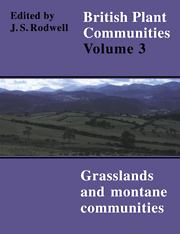Book contents
- Frontmatter
- Contents
- List of Figures
- Preface and Acknowledgements
- Preamble
- Mesotrophic Grasslands
- Community Descriptions
- Calcicolous Grasslands
- Community Descriptions
- Calcifugous Grasslands and Montane Communities
- Community Descriptions
- Index of Synonyms to Grasslands and Montane Communities
- Index of Species in Grasslands and Montane Communities
- Bibliography
U19 - Thelypteris Limbosperma-Blechnum Spicant Community
Published online by Cambridge University Press: 04 July 2020
- Frontmatter
- Contents
- List of Figures
- Preface and Acknowledgements
- Preamble
- Mesotrophic Grasslands
- Community Descriptions
- Calcicolous Grasslands
- Community Descriptions
- Calcifugous Grasslands and Montane Communities
- Community Descriptions
- Index of Synonyms to Grasslands and Montane Communities
- Index of Species in Grasslands and Montane Communities
- Bibliography
Summary
Synonymy
Thelypteris oreopteris community McVean & Ratcliffe 1962.
Constant species
Blechnum spicant, Galium saxatile, Oxalis acetosella, Potentilla erecta, Thelypteris limbosperma.
Rare species
Athyrium distentifolium.
Physiognomy
The Thelypteris limbosperma-Blechnum spicant community comprises what are sometimes quite dense stands of Thelypteris limbosperma with a variety of herbaceous and sub-shrub associates and a patchy ground cover of bryophytes. The fronds begin to unfurl in May, conspicuous right from the start in the way in which the yellow-green pinnae extend while the croziers are still coiled, and when fully grown they are virtually erect, growing in shuttlecock-like groups from the ends of the stocky, branched rhizomes (Page 1982). The fronds are quickly killed by autumn frosts, though in sheltered gullies they can stand, bleached and papery, well into the winter. On the other hand, the vegetative fronds of Blechnum spicant, the other constant fern of this community, persist winter-green, leathery and flattened against the ground, usually until after the emergence of the following season's foliage. It is generally not nearly so abundant as T. limbosperma, but it can be locally prominent, growing big and luxuriant with shelter. Very occasionally, there is also a little Dryopteris dilatata, Athyriumfilix-femina or, at higher altitudes, A. distentifolium. On drier ground this vegetation is also susceptible to invasion by Pteridium aquilinum, though stands in which this is abundant with T. limbosperma are best included in the Pteridium-Galium community.
Some stands have a distinctly heathy aspect, with well-grown clumps of Vaccinium myrtillus or Calluna vulgaris, less commonly V. vitis-idaea, while in others there is a quite extensive carpet of grasses among the ferns, with Festuca ovina, Agrostis capillaris, A. canina and Anthoxanthum odoratum all occurring quite frequently, Nardus stricta, Molinia caerulea, Holcus lanatus and Deschampsia cespitosa less often. Scattered throughout are Potentilla erecta, Galium saxatile and Oxalis acetosella with, more occasionally, Viola riviniana, Veronica officinalis, Rumex acetosa and Luzula sylvatica. Sometimes there is local enrichment from herbs like Teucrium scorodonia, Cirsium helenioides, C. palustre, Succisa pratensis and Primula vulgaris.
Bryophyte cover is rather variable, but Mnium hornum, Dicranum scoparium, Hylocomium splendens, Diplophyllum albicans and Pseudoscleropodium purum are all very common, Pleurozium schreberi, Rhytidiadelphus squarrosus, R. loreus, Polytrichum commune, Dicranum majus, Plagiothecium denticulatum and Hypnum cupressiforme s.l. somewhat less frequent, and these can form quite luxuriant patches over the fern stools and litter.
- Type
- Chapter
- Information
- British Plant Communities , pp. 483 - 486Publisher: Cambridge University PressPrint publication year: 1992

